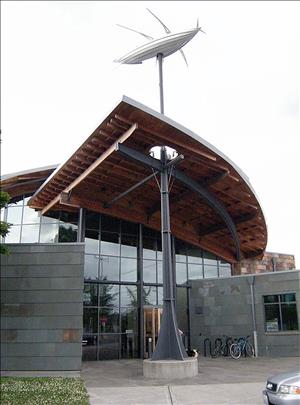The Beacon Hill Branch, The Seattle Public Library, is located on Seattle's Beacon Hill at 2821 Beacon Avenue S in a building financed by the 1998 "Libraries for All" bond issue. The branch opened in 1945 in a small storefront at 2708 Beacon Avenue S on a trial basis, with community-group members contributing time and money to make the branch possible. Beacon Hill became a full-fledged branch in 1947, and in 1962 moved into a converted retail store at 2519 15th Avenue S. Six years later a fire in the abutting building nearly destroyed the branch, but it was saved by heavy rain and occupied the storefront space for more than 40 years in all. The current building, designed by Carlson Architects, opened on July 10, 2004. It is three times the size of the previous one and includes special collections in Chinese, Vietnamese, Spanish, and Tagalog, reflecting some of the cultural diversity of the Beacon Hill neighborhood that it serves.
A Growing Community Needs a Library
During and after World War II, more people moved to the Beacon Hill community, transforming it from scattered small farms into a residential neighborhood. Owing to its low-cost housing and its proximity to the ethnically diverse Central Area, the neighborhood saw large growth in its African American and Asian populations.
It was during this period that Beacon Hill received its first library, which opened on October 22, 1945, in a small storefront building at 2708 Beacon Avenue S. For the first two years of its existence the branch operated on a trial basis, as specified by the Seattle Public Library board of trustees. During this time The Seattle Public Library supplied only books and staff and the neighborhood had to pay for the building’s rent and maintenance. Members of the Jefferson Park Ladies' Improvement Club, the Beacon Hill Community Club, and the Beacon Hill Parent-Teachers Association all contributed time, labor, and funds that made it possible for the fledgling branch to survive this first two years. Confident that there was sufficient support within the Beacon Hill community, the library board made Beacon Hill a full-fledged branch in 1947.
In 1962, the library moved into a former retail store at 2519 15th Avenue S, which provided a scant 3,200 square feet of space. The space had formerly been a grocery store, and lacked adequate ventilation, adequate seating, and sufficient shelf space.
The library and its contents came close to perishing in a 1968 fire that destroyed the variety store that abutted it, but was saved by heavy rain. In 1975 the library board purchased the library building.
Neighborhood Demographics
Today, the neighborhood remains culturally diverse. Less than 25 percent of the population is white compared to a citywide rate of 75 percent. Eighteen percent of the population is African American, while the largest population (54 percent) is Asian. Persons born on foreign soil constitute 10 percent of the population, compared to a citywide rate of 4 percent. After English, the most common languages spoken at home are Chinese, Tagalog, Japanese, and Vietnamese.
According to the 1990 census, Capitol Hill (including First Hill and Beacon Hill) is home to approximately 20,000 people, with a larger share of children compared to the rest of the city. Twenty-two percent of the population is younger than 16 years of age compared to 15 percent citywide. Residents tend to have less formal education compared to residents citywide, with 31.4 percent having less than a high school education, compared to 13.6 percent citywide.
The area has many fewer single person households (28.2 percent) compared to the citywide average of 40 percent, but a larger percentage of single parent households (14.7 percent) compared to a citywide rate of 6.2 percent. Incomes in the district tend to be lower, with median family incomes at $30,458 compared to $39,860 citywide. The district also has a higher poverty rate -- 19.3 percent compared to 12.4 percent citywide.
Population increased between 1980 and 1990. The population of the district under the age of 5 increased by 24 percent, and the population aged 65 years and older increased by 18 percent. During the same period, the number of people of color decreased by 20 percent, while the white population increased by 25 percent.
The new Beacon Hill Branch reflects the diversity of its neighborhood, with a capacity of 40,200 books, including special collections in the languages of the Pacific Rim. The building has 10,800 square feet, including a 400-square foot neighborhood service center, and features special areas for young adults, modern computer workstations, a meeting room, and adult reference reading areas.
Branch Managers
- (Not Available), 1945-1949
- L. Plennini, 1950-1959
- Norma O'Brian (clerk in charge), 1960-1966
- Mildred Gooksetter (clerk in charge), 1967-1977
- Regional Management, 1977-1990
- Julie Ann Oiye, July 1999-January 2008
- Misha Stone (interim branch manager), January-June, 2008
- Wei Cai, 2008-present

